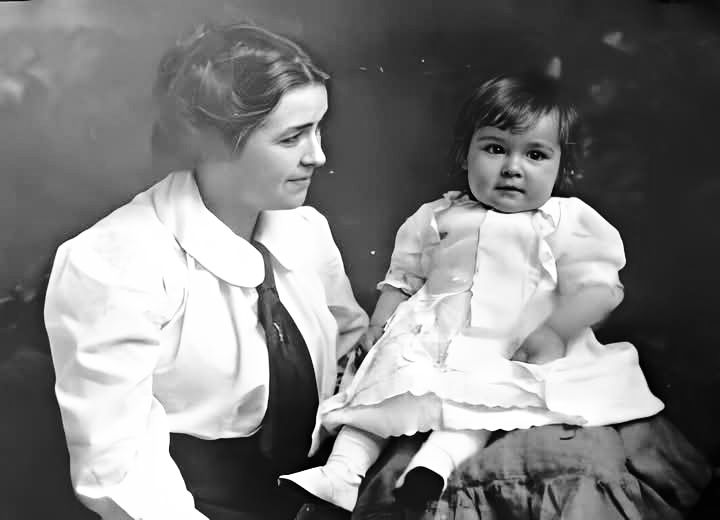The RMS Titanic, heralded as the epitome of luxury and modern engineering, set sail in April 1912 carrying not only the dreams of a new era but the deeply personal hopes of those aboard. Among the many tales of ambition, wealth, and tragedy that would emerge from the ship’s ill-fated maiden voyage, few are as poignant and romantic as the true story of Kate Phillips and Henry Morley—a love affair marked by daring defiance, tender devotion, and ultimate sacrifice.
In an age when societal expectations tightly bound individuals to their class, gender, and moral “station,” Kate and Henry dared to imagine a different future, one fueled by love rather than duty. Their story, although less well-known than the grand narratives portrayed in film and fiction, resonates across time, offering a glimpse into the deeply human struggles and emotions that the icy Atlantic could not sink.

A Love that Defied Society
Kate Phillips was a bright, spirited young woman of 19, working as a shop assistant in the bustling city of Worcester, England. Henry Morley, her employer, was a 47-year-old proprietor of a successful confectionery and fancy goods shop. By all outward appearances, he lived a respectable, prosperous life, complete with the responsibilities of marriage.
Yet behind the polished storefront windows, a romance was quietly blooming—one that challenged the rigid norms of Edwardian society.
Henry found himself captivated by Kate’s youthful charm and warm intelligence. Kate, for her part, was drawn to Henry’s confidence, worldliness, and the sense of adventure he promised.
It was a dangerous liaison.
Affairs between employers and employees, particularly when one was married, were scandalous enough to ruin reputations permanently. For Kate, discovery could mean disgrace; for Henry, social exile. But their love, reckless and hopeful, refused to be contained by convention.
In the spring of 1912, Henry made a radical decision: he would leave his marriage, his business, and his life in England behind. Together, he and Kate would flee to America—a land that, in the popular imagination of the time, represented second chances and new beginnings.
A New Identity: Mr. and Mrs. Marshall
The lovers knew their journey could not be undertaken openly. Gossip traveled fast, and scandal even faster.
They adopted the aliases “Mr. and Mrs. Marshall” and booked passage aboard the Titanic as second-class passengers. Their cabin, modest compared to the opulent first-class suites, was still a haven of dreams—a place where they could imagine the life they were about to forge together across the Atlantic.
As they embarked in Southampton on April 10, 1912, their spirits must have been buoyant. The Titanic itself was a symbol of ambition and progress, much like their own daring escape from the old world’s constraints. They were not alone in seeing the ship as a vessel of new beginnings; hundreds of immigrants and dreamers crowded the lower decks with similar hopes.
But for Kate and Henry, this was more than migration.
It was an act of rebellion, a declaration that love mattered more than social standing, more than reputation.
A Token of Love: The Necklace
During the voyage, Henry gifted Kate a delicate necklace adorned with a deep blue sapphire—a modest but heartfelt token of his devotion.
This piece of jewelry, simple yet precious, became a tangible representation of their commitment.
Though far less extravagant than the fictional “Heart of the Ocean” necklace popularized by James Cameron’s Titanic film, Kate’s necklace symbolized something even more profound: a shared willingness to abandon the familiar for the uncertain, to choose love over duty.
It is believed that the tender relationship between Kate and Henry, particularly the idea of a young woman falling for a man from a different background and boarding the Titanic with dreams of a new life, partly inspired the story of Jack and Rose—an enduring fictionalization of romance against impossible odds.
But unlike Jack and Rose, Kate and Henry’s story was heartbreakingly real.
The Night the Dream Shattered
The evening of April 14, 1912, began like any other aboard the Titanic—music, laughter, and the genteel rituals of shipboard life. No one could have foreseen that by night’s end, the ship would be fatally wounded.
At 11:40 p.m., the Titanic struck an iceberg. Within minutes, confusion and fear began to ripple through the decks. Crew members, struggling to understand the extent of the damage, moved to awaken passengers and prepare the lifeboats.
For Kate and Henry, the frantic chaos must have been surreal. They had set out in pursuit of freedom, only to find themselves facing mortality.
Following the ship’s protocol—”women and children first”—Kate was ushered toward the lifeboats. Lifeboat 11, crowded but still with room for a few more souls, became her escape.
Henry remained behind, as so many men did that night, standing on the deck as the sea crept ever closer.
There is no record of Henry attempting to board a lifeboat.
Perhaps he believed there was no place for him.
Perhaps he chose honor over survival.
Or perhaps he simply could not bear the thought of pushing another soul aside to save himself.
Whatever his reasons, Henry Morley perished that night as the Titanic slipped beneath the frigid waters of the North Atlantic.
Survival and Grief
Kate, shivering and traumatized, survived the long, harrowing night. She was rescued by the RMS Carpathia, along with over 700 other survivors.
But survival carried its own terrible burdens.
In the weeks that followed, the full scope of her loss became clear.
Henry, her lover and the father of her unborn child, was gone.
Kate returned to England, carrying within her the living legacy of their love.
In December 1912, she gave birth to a daughter—whom she named Ellen “Betty” Phillips.
It is impossible to fully imagine the loneliness Kate must have faced: a young, unmarried mother in a judgmental society, mourning a love she could not publicly acknowledge, raising a child in a world that barely understood her tragedy.
Yet she persevered, supported in part by Henry’s brother, who helped provide for the child. Kate eventually married, but she never forgot Henry or the extraordinary chapter of her life they had shared.
The Necklace and Its Legacy
The sapphire necklace that Henry gave to Kate survived the sinking, tucked safely among her few salvaged possessions.
It became a precious heirloom—an enduring reminder of a love that had been tested by fire and ice.
Decades later, as interest in Titanic stories blossomed anew, particularly after the 1997 film, historians and writers rediscovered Kate’s story.
Though her name does not appear in the official passenger lists under her real identity, the “Marshalls” are recorded among the second-class travelers.
Through letters, family testimony, and Titanic research, the pieces of her life were slowly, lovingly reassembled.
Kate’s narrative, although quieter than the grand tales of millionaires and titled aristocrats, adds a profoundly human layer to the Titanic saga.
It reminds us that aboard that doomed ship were not just symbols of a gilded age, but real people with real dreams, hearts full of love, and futures cut brutally short.
A Universal Story
In the end, the story of Kate Phillips and Henry Morley is not just about a historic disaster.
It is about the courage to follow one’s heart, the price of love, and the resilience of the human spirit in the face of devastating loss.
Their experience transcends time, reaching across more than a century to touch us even now.
In a world still grappling with questions of courage, sacrifice, and the pursuit of happiness, their journey offers enduring lessons.
Love is often a leap into the unknown.
It demands risk.
It defies certainty.
It dares to hope when hope seems foolish.
Kate and Henry’s brief, shining story stands as a tribute to the belief that some things—love, honor, devotion—are worth everything, even when the world seems destined to crush them.
Remembering Kate Phillips
Kate lived until 1964, witnessing two world wars, the collapse of the British Empire, and the profound technological and cultural changes of the 20th century.
Yet throughout her long life, she remained shaped by that fateful journey aboard the Titanic.
She rarely spoke publicly about her experience.
Like so many survivors, the memories were too painful, the grief too private.
But through her daughter Betty and subsequent generations, her story has been preserved—a whispered reminder that beneath the grandeur of history, it is always the individual stories that matter most.
The Titanic may have been called the “Ship of Dreams,” but for Kate Phillips, it was both the vessel of her greatest hope and the crucible of her greatest sorrow.
Her love, and her loss, endure.
Not in marble statues or grand memorials, but in the simple, beautiful truth that even amid tragedy, love leaves an indelible mark.


